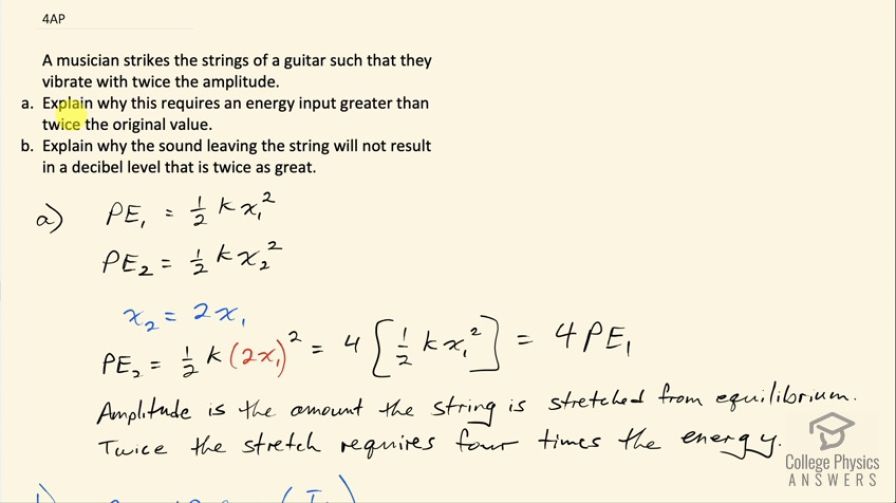Question
A musician strikes the strings of a guitar such that they vibrate with twice the amplitude.
- Explain why this requires an energy input greater than twice the original value.
- Explain why the sound leaving the string will not result in a decibel level that is twice as great.
Final Answer
- Amplitude is the amount the string is stretched from equilibrium. Twice the stretch requires giving the string four times the elastic potential energy.
- Please see the solution video.
Solution video
OpenStax College Physics for AP® Courses, Chapter 17, Problem 4 (Test Prep for AP® Courses)

vote with a rating of
votes with an average rating of
.
Calculator Screenshots
Video Transcript
This is College Physics Answers with Shaun Dychko. A musician strikes a string such that the string vibrates with twice the amplitude. So in part (a), we have to explain why this requires an energy input from the musician that's greater than twice the original value at the original amplitude. So the energy that has to be input into the string is to give it elastic potential energy which has a formula one-half times the spring constant times the amount of stretching squared. So in the first case, it's stretched one amount squared and in the second case, it will have a potential energy due to the second amount of stretching x 2 squared and x 2 is gonna be twice x 1. So if we substitute 2x 1 in place of x 2, we have 4 times one-half kx 1 and this is potential energy one. So the potential energy in the second case is four times the potential energy in the first case and so twice the stretch requires four the times the energy. In part (b), we are asked explain why the sound leaving the string will not result in a decibel level that is twice as great? So decibel level is 10 times the logarithm base 10 of whatever intensity the sound has divided by some reference intensity at the threshold of hearing and so we have decibel level one is all of this with intensity one and decibel level two is the same thing but with this second intensity and intensity for sound is the pressure amplitude which is proportional to the physical oscillating amplitude squared divided by 2 times the density of air times the speed of the sound through the air and intensity in the second case will be the pressure amplitude in the second case squared divided by the same factors and the pressure amplitude in the second case will be twice the pressure amplitude in the first case and so we can plug in 2ΔP 1 in place of ΔP 2 and we have 4 times this expression which is intensity one. So intensity two is gonna be 4 times intensity one and when we take the difference between these two decibel levels, we have 10 times logarithm base 10 of I 2, which I am writing as 4I 1 over I naught minus 10 log base 10 I 1 over I naught we can factor the 10 out and then we have the difference between two logarithms and when you have the difference between two logarithms of the same base, you can take the first argument and divide it by the second argument. So I have log base 10 of 4I 1 over I naught divided by this which I write as multiply by its reciprocal and the I naught's cancel and the I 1's cancel and we have 10 log base 10 of 4 is the difference between these two decibel levels, which is 6.
